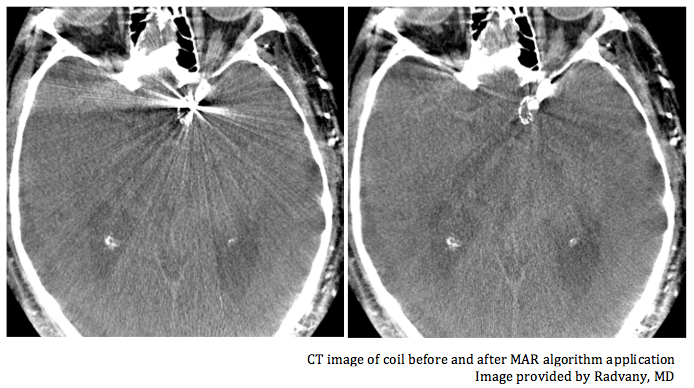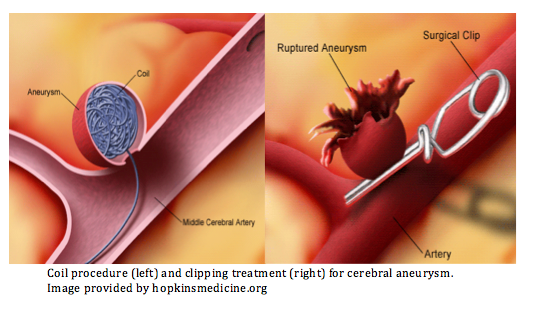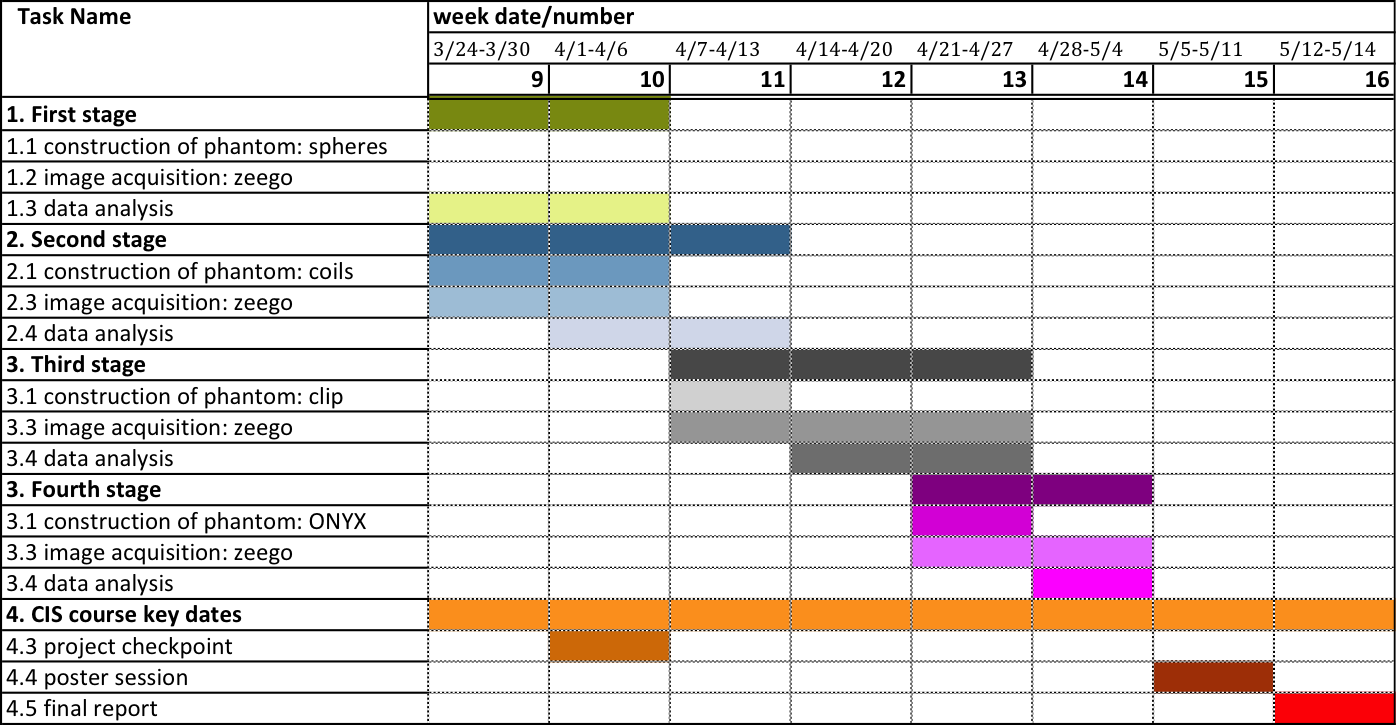Table of Contents
Metal Artifact Removal in C-Arm Cone Beam CT
Last checked: 05/08/13, 10:00 pm
Summary
The aim of this project is to construct brain phantoms and acquire CT images for a quantitative analysis and assessments of (a) image quality and (b) metal artifact removal algorithm application.
- Students: Carolina Cay-Martinez, Marta Wells
- Mentor: Jeffrey Siewersden, PhD
- Project Advisors: Martin Radvany, MD (Interventional Radiology), Tina Ehtiati, PhD (Siemens Healthcare)
Background, Specific Aims, and Significance
Clinical Background
Neurovascular interventions are minimally invasive interventional radiology procedures performed in blood vessels of head and neck for treatment of diseases such as aneurysms, intercranial stenosis, and arteriovenous malformations(AVMs). Treatment of these diseases, which include the use of clips, coils, stents and other metal-based materials, depend on 3D CT imaging acquisition in the surgical environment.
Technical Background
X-ray computed tomography (CT) is a radiographic imaging modality that uses reconstruction methods to create cross-sectional images from x-ray attenuation data. Artifacts is a terms that refers to any discrepancy between attenuation data of the reconstructed image and the true attenuation coefficient of the object. Metal artifacts are artifacts caused by the presence of dense metal materials in the object. These are caused mainly by a phenomenon called beam-hardening, which refers to the change of the mean energy of the exiting-photons energy spectrum due to the greater absorbance of lower-energy photons by the object. Metal artifacts can seriously degrade the image quality of a CT image. Metal Artifact Removal (MAR) algorithms have been developed to reduce and/or remove these artifacts, and are ready for clinical testing.
Specific Aims
1. Construction of anthropomorphic brain phantoms to simulate varying metal artifacts (coils, clips, etc) and the surrounding vasculature.
2. Image acquisition in C-arm Cone-Beam CT scanner.
3. Quantitative data analysis of image quality and segmentation accuracy.
4. MAR algorithm application, analysis and assessment.
Significance
Optimizing image quality through MAR algorithms will ensure a safer, more accurate use of CT imaging in the surgical environment for both diagnoses and treatments.
Available Resources
- Hollow brain phantom and insert materials
Available for the project is a hollow anthropomorphic head phantom, ‘scarecrow’, which can be filled with materials that can simulate cerebral tissue, contrast vasculature, metal materials used in surgical interventions (coils and/or clips), etc.
- Experimental Imaging Bench
CT dual energy Cone-Beam imaging system available at the I-STAR lab, Johns Hopkins Medical Campus
- Zeego/Axiom Artis Zee Imaging System
C-arm Cone-Beam 3D CT imaging system available at the Interventional Radiology suite, Johns Hopkins Medical Campus
Deliverables
- Phantom Construction
- Minimum: containing metal sphere and contrast vasculature
- Expected: one containing stent, coils and contrast vasculature. One phantom containing surgical clips and contrast vasculature (Original plan: containing coils and/or clips and contrast vasculature)
- Maximum: containing ONYX and contrast vasculature
- Image Acquisition
- Minimum: workbench; flat panel, cone-beam CT in lab.
- Expected: Zeego (C-arm, cone-beam, Siemens CT system)
- Maximum: none (Original plan: construct converter to transfer data from bench to Zeego workstation)
- MAR Algorithm
- Minimum: run and implement algorithm
- Expected: adapt for performance improvement
- Maximum: suggest algorithm improvement (Original plan: extend and apply improvements)
- Data Analysis: Image Quality
- Minimum: quantitatively measure contrast resolution (CNR)
- Expected: noise standard deviation (Original plan: measure spatial resolution, artifact magnitude)
- Maximum: artifact magnitude
- Data Analysis: Segmentation Accuracy
- Minimum: application of segmentation algorithm on image data
- Expected: quantitatively measure segmentation accuracy
- Maximum: segmentation algorithm improvement suggestions
Technical Approach
The project is comprised of four (Original plan: three) stages: each will consist of the construction of a brain phantom, acquisition of phantom images and the assessment and analysis of image quality and MAR algorithm data. Below are quantitative and/or measurable variables and parameters.
Phantom Construction
- Dependent variables in metal fillings
- for spheres and clips: quantity, diameter, material, location in relation to contrast vasculature and anatomy
- for clips and stents: quantity, material, diameter, length
- Dependent variables in simulated vasculature
- number of vessels, contrast, volume, length, shape, material (silicon, brain-equivalent jello, among others), location in the brain representative of various anatomical structures including berry aneurysms, taking into consideration areas of the brain where aneurysms are most commonly found.
Manipulation of these variables will produce wanted measurable parameters (such as attenuation and contrast).
Image Acquisition
- Dependent variables in imaging systems
- Energy of beam (kVp), number of projections, z-coverage (FOV)
All scans were performed on a C-arm Cone-Beam Axiom Artis Zee (Axiom Artis Zeego, Siemens Medical Solutions, Elangen, Germany) with a standard DynaCT Head 20s 70keV acquisition.
Data Analysis
- Image quality
- Measurable parameters: Contrast resolution (CNR), resolution, noise std
- Artifact magnitude with selected ROI (region of interest)
- Segmentation accuracy
The MAR algorithm will be available in the Syngo workstation (Software in the Zeego console). We will have constructed the phantom with objects of known size and shape in particular locations so that we will be able to accurately assess the precision of the MAR algorithm in improving the image. Parameters for quantifying the exact discrepancies in the reduction of metal artifacts will be developed as needed.
Dependencies
Experimental Imaging Bench
- Dependency: Availability
- Resolution: Image acquisition will be done on a two-week period range in every project stage (3). Scheduling depends on Dr. Siewersden and lab members.
- Back-up plan: Zeego system will be used instead.
- Resolved by: End of each brain phantom construction period.
- Affects: Image acquisition for image quality assessment.
- Dependency: Training/Supervision
- Resolution: Training of equipment will occur during 2/17-2/23. Lab member supervision (if required) ill be scheduled previously.
- Back-up plan:
- Resolved by: 2/17-2/23
- Affects: Image acquisition for image assessment.
Zeego/Axiom Artis Zee
- Dependency: Availability
- Resolution: Image acquisition will be done on a three-week period range in every project stage (3). Late afternoon/outside of clinical hours scheduling will be preferred. This imaging system is in clinical used and therefore has an undependable schedule. Scheduling depends on Dr. Ehtiati.
- Back-up plan: Bench system will be used instead.
- Resolved by: End of each brain phantom construction period.
- Affects: Image acquisition for MAR assessment.
- Dependency: Training/Supervision
- Resolution: Supervision (by Dr. Ehtiati or technician) will be needed during each image acquisition.
- Back-up plan:
- Resolved by: End of each brain phantom construction period.
- Affects: Image acquisition for MAR assessment.
Brain Phantoms and Materials
- Dependency: Availability
- Resolution: The I-STAR lab already is in possession of the phantom (just available to us this semester) and insert material (brain equivalent jello, soft-tissue inserts, coils, stents, etc)
- Back-up plan: If the material is not available in the lab, then a request will be made to Dr. Siewersden for ordering at least two weeks prior of its intended use.
- Resolved by: End of each image acquisition period.
- Affects: Further image acquisition.
Other
- Dependency: Software available in experimental imaging bench
- Dependency: Software available in Zeego imaging system (Syngo workstation)
- Dependency: Travel to/from Homewood/Medical Campus
- Dependency: Availability of Dr. Radvany and technicians
- Dependency: Permissions constraints
- Permission to operate Zeego and/or bench
- Access to hospital interventional radiology suite
- Access to the I-STAR lab
Milestones and Status
Note: 'planned date' refers to the planning period while 'expected date' refers to the end of the milestone.
- Milestone name: Construction of first-stage Phantom [metal sphere]
- Expected Date: 3/2
- Status: completed
- Milestone name: First-stage image acquisition in Zeego
- Expected Date: 3/23
- Status: completed
- Milestone name: Construction of second-stage Phantom [stent and coils]
- Expected Date: 3/30
- Status: completed
- Milestone name: Second-stage image acquisition in Zeego
- Expected Date: 4/20
- Status: completed
- Milestone name: Construction of third-stage Phantom [liquid embolus]
- Expected Date: 4/13
- Status: complete
- Milestone name: Third-stage image acquisition in Zeego
- Expected Date: 4/20
- Status: complete
- Milestone name: Construction of fourth-stage Phantom [clip]
- Expected Date: 4/27
- Status: complete
- Milestone name: Fourth-stage image acquisition in Zeego
- Expected Date: 5/04
- Status: incomplete
Original Schedule
Revised Schedule
Reports and presentations
- Project Plan
- Project Background Reading
- See Bibliography below for links.
- Project Checkpoint
- Project Reports
- Paper Seminar Presentations
- Project Final Presentation
- Project Final Report
Materials last updated: 04/29 7:00pm
Project Bibliography
[1] Barrett, J. F., and N. Keat. “Artifacts in CT: Recognition and Avoidance.” Radiographics
24.6 (2004): 1679-691. Print.
[2] Prince, Jerry L., and Jonathan M. Links. Medical Imaging Signals and Systems. Upper Saddle River, NJ: Pearson Prentice Hall, 2006. Print.
[3] Müller, J.; Buzug, T. M. “Spurious structures created by interpolation-based CT metal artifact reduction.” Medical Imaging 2009: Physics of Medical Imaging. Proceedings of the SPIE, Volume 7258 (2009).
[4] B. De Man1, J. Nuyts2, P. Dupont2, G. Marchal3, and P. Suetens.“Reduction of metal streak artifacts in x-ray computed tomography using a transmission maximum a posteriori algorithm.” IEEE Transactions on Nuclear Science, vol. 47, nr. 3, 2000, pp. 977-981.
[5] Meyer, Esther, Rainer Raupach, Michael Lell, Bernhard Schmidt, and Marc Kachelrieß. “Normalized Metal Artifact Reduction (NMAR) in Computed Tomography.” Medical Physics 37.10 (2010): 5482. Print.
[6] Meyer, Esther, Rainer Raupach, Michael Lell, Bernhard Schmidt, Marc Kachelrieß. “Frequency split metal artifact reduction (FSMAR) in computed tomography.” Medical Physics 39.00 (4), April 2012. Print.
[7] P. Stradiotti, A. Curti, G. Castellazzi, A. Zerbi. “Metal-related artifacts in instrumented spine. Techniques for reducing artifacts in CT and MRI: state of the art” Eur Spine J. 2009 June; 18(Suppl 1): 102–108. Published online 2009 May 13.
[8] Prell, D., Y. Kyriakou, T. Struffert, A. Dorfler, and W. A. Kalender. “Metal Artifact Reduction for Clipping and Coiling in Interventional C-Arm CT.” American Journal of Neuroradiology 31.4 (2010): 634-39. Print.
Other Resources and Project Files
- MATLAB code for ROI selection and value acquisition from DICOM images





